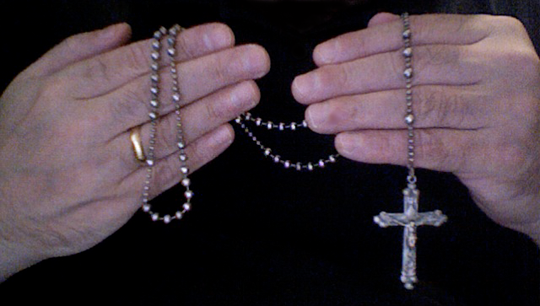
Q. What is the Rosary?
The Holy Rosary is a devotion in which many prayers are recited or chanted in a particular order. The term “Rosary” also refers to the beads which Roman Catholics use to count and keep track of their Rosary prayers.
Q. Why should we pray the Rosary?
The Rosary is a great weapon against evil — be it evil from without, or evil from within our own hearts. Bishop Hugh Boyle famously remarked, “No one can live continually in sin and continue to say the Rosary. Either he will give up the sin or he will give up the Rosary”.
In his book The Secret of the Rosary, St. Louis De Montfort (1673-1716) reveals that those who commit to praying the Rosary every day gain extraordinary power from God to change their lives and perform mighty works of faith. Of this “secret”, De Montfort writes:
“When the Holy Spirit has revealed this secret to a priest and director of souls, how blessed is that priest! For the vast majority of people fail to know this secret or else only know it superficially. If such a priest really understands this secret he will say the Rosary every day and will encourage others to say it. God and His Blessed Mother will pour abundant grace into his soul, so that he may become God’s instrument for His glory; and his word, though simple, will do more good in one month than that of other preachers in several years.” (1)
St. Louis-Marie Grignion de Montfort (1673-1716)
In the second chapter, addressing common sinners, De Montfort writes:
“If you say the Rosary faithfully until death, I do assure you that, in spite of the gravity of your sins, `you shall recieve a never fading crown of glory’ [1 Peter 5:4]. Even if you are on the brink of damnation, even if you have one foot in hell, even if you have sold your soul to the devil as sorcerers do who practice black magic, and even if you are a heretic as obstinate as a devil, sooner or later you will be converted and will amend your life and save your soul, if — and mark well what I say — if you say the Holy Rosary devoutly every day until death for the purpose of knowing the truth and obtaining contrition and pardon for your sins.” (2)
St. Louis-Marie Grignion de Montfort (1673-1716)
Q. What is the origin and meaning of the word “Rosary”?
The Latin word for “Rosary” is Rosarium. Originally, rosarium simply meant “rose garden“. (3) How the Catholic prayer beads came to be associated with a rose garden is not entirely clear, but Catholic tradition honors the rose as a symbol of the Virgin Mary, to whom the Rosary is specially devoted.
Through the ages, Catholic writers have likened the recitation of the Rosary to an offering of roses to the Blessed Mother, with each prayer representing a rose, and the Rosary itself symbolizing a garland. (4)
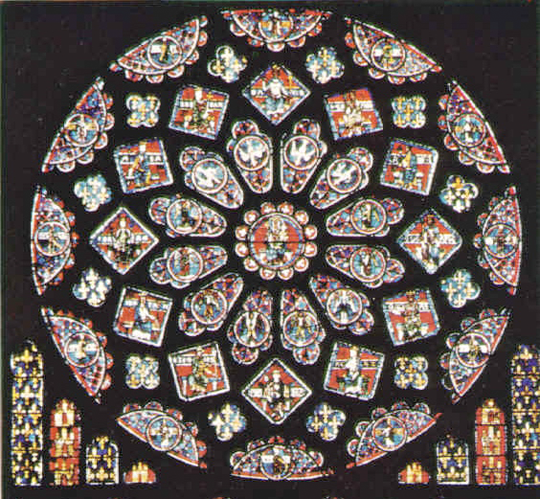
The Great Rose Window shown above dominates the north transept of the Cathedral of Our Lady of Chartres (Cathédrale Notre-Dame de Chartres), built in Chartres, France, from AD 1145 to 1260.
Q. Which prayers are recited in the Rosary?
The Rosary consists of 150 Hail Marys, 15 Our Fathers, and a series of meditations upon 15 Sacred Mysteries, representing fifteen significant events in the lives of Jesus and Mary.
Other types of Catholic prayer beads are sometimes called “rosaries”, but this usage is not quite accurate. These other devotions are perfectly valid, but the Church does not call them “rosaries”. When official Church documents speak of the “Rosary”, they invariably mean the Dominican Rosary of 150 Hail Marys, 15 Our Fathers and 15 Sacred Mysteries.
Other types of devotions often mistakenly called “rosaries” include the Franciscan Crown, the Servite Chaplet of the Seven Sorrows and many others.
Q. Does the Church set rules concerning the Rosary?
The Rosary is a private devotion, whose method of practice is subject to a wide range of personal choice. However, the Church does set minimal standards as to what constitutes a Rosary. It defines a Rosary as the praying of 150 Hail Marys, 15 Our Fathers, and meditation upon the 15 Sacred Mysteries. If you leave out any of the above, you are not praying an actual Rosary as defined by the Church. Other prayers and meditations can be added to those mentioned above, according to local custom or personal choice, but such additions are considered optional.
Q. Why should we sing the Rosary instead of just reciting it?
It is of course commendable to recite any prayer, including the Rosary, in a plain voice, without song. However, sages and saints, from earliest times, have taught that singing a prayer is more powerful than speaking it — a teaching summarized in the famous Roman maxim, “He who sings well prays twice”. (Qui bene cantat, bis orat.)
St. Augustine of Hippo expanded upon this theme when he wrote: “He who sings praise, does not only praise, but also praises joyfully; he who sings praise, not only sings, but also loves Him about whom he sings.” (Qui enim cantat laudem, non solum laudat, sed etiam hilariter laudat; qui cantat laudem, non solum cantat, sed et amat eum quem cantat.) (5)
The Church teaches that Gregorian chant is a form of music “specially suited to the Roman liturgy“. (6) While the Rosary is not a public liturgy, but rather a private devotion, many of its prayers are identical with those used in the Mass. Indeed, Pope John Paul II called the Rosary, “a faithful echo of the Liturgy“. (7) Gregorian chant therefore seems well-suited for singing the Rosary.
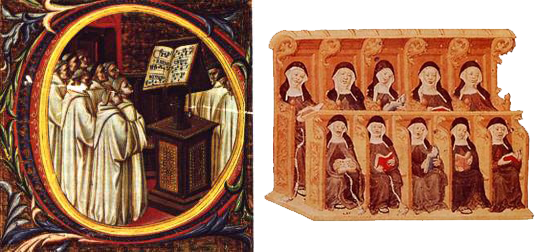
Both sexes have traditionally taken part in singing Gregorian chant. Pictured above are choirs of medieval monks (left) and medieval nuns (right). The painting on the right portrays Dominican nuns of Notre Dame de Prouille, whose convent Saint Dominic founded in A.D. 1206.
Q. What is Gregorian chant?
Gregorian chant is the traditional liturgical music of the Roman Catholic Church. It has been used for centuries to sing the Mass and for other types of worship services.
Gregorian chant is derived from a much older and larger family of music called plainchant or plainsong (from the Latin cantus planus). In its strictest form, plainchant allows no instruments other than the human voice. The music follows a single melody line, with no harmonizing. Every singer in the choir chants the same tune in unison.
Plainchant existed long before Christianity. Extremely ancient versions of plainchant still survive in the ceremonies of Jews, Armenians and the Coptic Christians of Egypt, for example.
Early Christians adopted plainchant for their worship. Many varieties developed within the Church. In the East, the Byzantine, Coptic and Armenian styles flourished. In the West, the Roman style gained ascendancy.
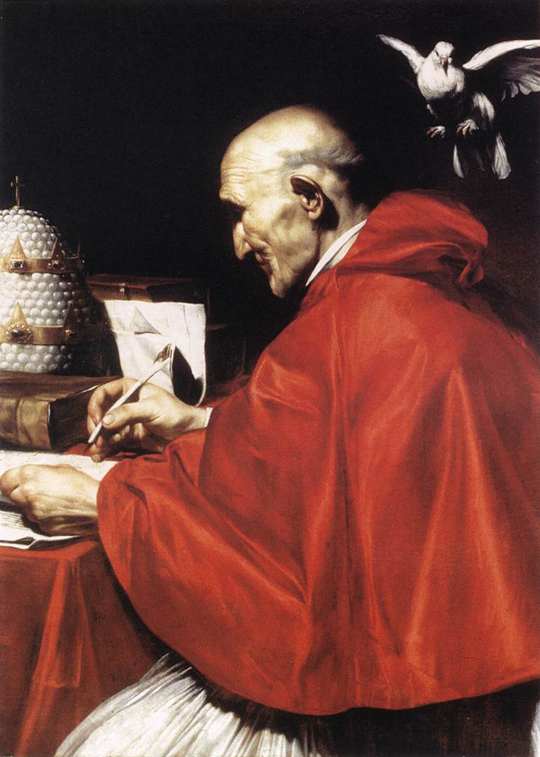
Pope Gregory the Great, who reigned from AD 590 – 604, founded a schola cantorum which promoted Roman plainchant throughout the Empire.
Gregorian chant descends directly from the Roman or Old Roman style of plainchant. By the time of Pope Gregory the Great (AD 590 – 604), a number of regional chanting styles had developed within the Western Church, such as the Gallican (in the province of Gaul), Ambrosian (in northern Italy), Celtic (in the British Isles) and Mozarabic (in Spain). (8)
Pope Gregory the Great compiled the chants of the Old Roman liturgy, and established a schola cantorum in Rome — a school of singing — which propagated the Old Roman style of plainchant across the Empire. Over time, the Roman or “Gregorian” style spread throughout the Western Church, replacing other regional styles. (9)
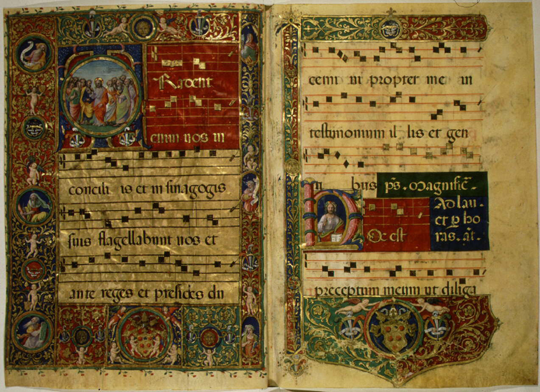 Illuminated manuscript, circa 1520, showing the square-note neum musical script used for transcribing Gregorian chant. This particular manuscript was written for Pope Leo X (Giovanni de’ Medici), who reigned from 1513-21. It resides today in the Vatican’s Capella Sistina collection. Go here for a close-up.
Illuminated manuscript, circa 1520, showing the square-note neum musical script used for transcribing Gregorian chant. This particular manuscript was written for Pope Leo X (Giovanni de’ Medici), who reigned from 1513-21. It resides today in the Vatican’s Capella Sistina collection. Go here for a close-up.
Q. Did medieval people sing the Rosary in Gregorian chant?
Evidently they did. Historical literature abounds with references to “singing” or “chanting” the Rosary, as distinct from “saying” or “reciting” it. For example, St. Louis de Montfort writes, “There are several ways of saying the Holy Rosary, but that which gives Almighty God the greatest glory… is that of saying or chanting the Rosary publicly in two groups (c’est de le psalmodier ou réciter publiquement à deux choeurs).” (10) Significantly, De Montfort does not use the verb chanter (“to sing”) in this passage, but rather psalmodier, a term of art specific to the singing of liturgical chant. Its literal meaning is “to Psalmodize” or to sing Psalms.
Q. Who are you? What are your qualifications?
By profession, I am a writer and journalist, and the author of several bestselling books. Regarding Gregorian chant and the Rosary, I am entirely self-taught. While I did have some formal schooling in Latin (three years in high school and one year in college), I claim no special expertise in that language. Likewise, my formal training in music is confined to a few years of piano and French horn lessons during childhood. Readers are urged to measure the value of this tutorial not by my personal credentials, which are scant, but rather by the caliber of the scholarly and ecclesiastical authorities upon whose work I rely, and from whom I have drawn the facts presented in these pages.
– Richard Poe
________________________________________
NOTES
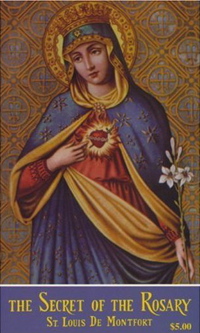 |
1. St. Louis De Montfort, The Secret of the Rosary. Translated by Mary Barbour, T.O.P. (Rockford, IL: TAN Books & Publishers, 1976), 9, “A White Rose for Priests”
St. Louis De Montfort, The Secret of the Rosary. Translated by Mary Barbour, T.O.P. Published 1954. Bay Shore, New York: Montfort Publications. Nihil Obstat, July 16, 1954, Gulielmus F. Hughes, S.T.L., Censor. Imprimatur. +Thomas Edmund Molloy, S.T.D., Archbishop of Brooklyn
St. Louis-Marie Grignion de Montfort, Le Secret Admirable du Très Saint Rosaire pour se convertir et se sauver
2. ibid., 12, “A Red Rose for Sinners”
________________________________________
3. “rosary“, Online Etymology Dictionary, Douglas Harper, retrieved 25 August 2007.
4.
5. Sanctus Augustinus, Enarratio in Psalmum 72, 1: CCL 39, 986 (PL 36, 914)
6. The Constitution on the Sacred Liturgy, Second Vatican Council, Chapter VI:116, 4 December 1963
7. Pope John Paul II, Apostolic Letter Rosarium Virginis Mariae (16 October 2002)
8. H. Bewerung, “Gregorian Chant,” The Catholic Encyclopedia, Volume XII. Published 1911. New York: Robert Appleton Company. Nihil Obstat, June 1, 1911. Remy Lafort, S.T.D., Censor. Imprimatur. +John Cardinal Farley, Archbishop of New York
ibid. “Plain Chant”
9. “Gregorian Chant“, The Catholic Encyclopedia, 1911
ibid., “Plain Chant”
10. St. Louis De Montfort, The Secret of the Rosary, 96
Posted August 28, 2007. Updated September 6, 2007.